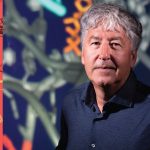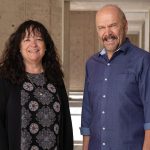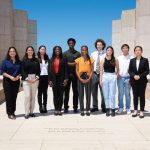Professor Juan Carlos Izpisua Belmonte and colleagues from King Abdullah University of Science and Technology (KAUST) in Saudi Arabia have discovered a new underlying cause of Wiskott-Aldrich syndrome, a rare genetic disease that leads to bleeding and immune deficiencies in babies. Their findings involve the way cells cut and paste strands of RNA in a process called RNA splicing. The genetic mutations associated with Wiskott-Aldrich syndrome, they found, disrupt this process, ultimately preventing numerous immune and anti-inflammatory proteins from being made correctly.
Read News ReleaseDiscoveries
Hair-raising research: The fascinating link between the immune system and hair growth
Associate Professor Ye Zheng, first author Zhi Liu, and colleagues have uncovered an unexpected molecular target of a common treatment for alopecia, a condition in which a person’s immune system attacks their own hair follicles, causing hair loss. Their findings describe how immune cells interact with skin cells using a hormone as a messenger to generate new hair follicles and hair growth.
Read News ReleaseImaging solves mystery of how large HIV protein functions to form infectious virus
Assistant Professor Dmitry Lyumkis, co-first author Dario Passos, and colleagues from Rutgers University have determined the molecular structure of HIV Pol, a protein that plays a key role in the late stages of HIV replication—the process through which the virus propagates itself and spreads through the body. The molecule’s structure helps answer long-standing questions about how the protein breaks itself apart to advance the replication process. The discovery reveals a new vulnerability in the virus that could be targeted with drugs.
Read News ReleaseMaking a memory positive or negative
Professor Kay Tye, co-first author Hao Li, and team have discovered a molecule in the brain responsible for associating good or bad feelings with a memory. Their finding paves the way for a better understanding of why some people are more likely to retain negative emotions than positive ones—as can occur with anxiety, depression, or post-traumatic stress disorder (PTSD).
The best offense is a great defense for some carnivorous plants
Insect-eating plants have fascinated biologists for more than a century, but how plants evolved the ability to capture and consume live prey has largely remained a mystery. Professor Joanne Chory, Staff Scientist Carl Procko, and colleagues from Washington University in St. Louis have found evidence that plant carnivory evolved from mechanisms plants use to defend themselves. The findings broaden scientists’ understanding of how plants interact with their environments.
Discovery advances the potential of gene therapy to restore hearing loss
Sensory hair cells in the inner ear use long, hair-like structures called stereocilia to transduce sound. In the absence of the protein EPS8, stereocilia are too short to function, leading to deafness. Assistant Research Professor Uri Manor and colleagues from the University of Sheffield found that delivery of EPS8 can rescue stereocilia elongation and function in mice affected by the loss of EPS8. Their study shows promise for the development of gene therapies to repair hearing loss.
Read News ReleaseSurprising link between mitochondrial DNA and increased atherosclerosis risk
Mitochondria are known as cells’ powerhouses, but mounting evidence suggests they also play a role in inflammation. Professor Gerald Shadel and colleagues from UC San Diego examined human blood cells and discovered a surprising link between mitochondria, inflammation, and DNMT3A and TET2—two genes that normally help regulate blood cell growth but, when mutated, are associated with an increased risk of atherosclerosis.
Read News ReleaseNew target identified for treatment of premature aging disease
Professor Juan Carlos Izpisua Belmonte, co-first author Pradeep Reddy, and colleagues from KAUST in Saudi Arabia have discovered that a stretch of DNA that hops around the human genome plays a role in premature aging disorders. In people with early aging, or progeria, RNA encoded by this mobile DNA builds up inside cells. What’s more, the scientists found that blocking this RNA reverses the disease in mice.
Read News ReleaseLight and temperature work together to affect plant growth
Plants lengthen and bend to secure access to sunlight, yet scientists do not fully understand this process. Professor Joanne Chory, first author Yogev Burko, and colleagues have discovered that two plant factors—the protein PIF7 and the growth hormone auxin—are the triggers that accelerate growth when plants are shaded by canopy and exposed to warm temperatures at the same time. The findings will help scientists increase crop productivity despite the yield-harming global temperature rise.
Read News ReleaseBeyond neurons: How cells called astrocytes contribute to brain disorders
Neurons often get most of the credit for keeping our brains sharp and functioning—as well as most of the blame when it comes to brain diseases. But star-shaped cells called astrocytes, another abundant cell in the human brain, may bear the brunt of the responsibility for exacerbating the symptoms of some neurodevelopmental disorders. Associate Professor Nicola Allen and colleagues have now identified a molecule produced by astrocytes that interferes with normal neuron development in Rett, fragile X, and Down syndromes.
Read News ReleaseHow the brain gathers threat cues and turns them into fear
Assistant Professor Sung Han, co-first authors Sukjae Joshua Kang and Shijia Liu, and colleagues have uncovered a molecular pathway that distills threatening sights, sounds, and smells into a single message: Be afraid. A molecule called CGRP enables neurons in two separate areas of the brain to bundle threatening sensory cues into a unified signal, tag it as negative, and convey it to the amygdala, which translates the signal into fear. The research may lead to new therapies for fear-related disorders such as PTSD or hypersensitivity disorders such as autism, migraines, and fibromyalgia.
Read News ReleaseAggression de-escalation gene identified in fruit flies
The brain mechanisms that cause aggressive behavior have been well studied. Far less understood are the processes that tell the body when it’s time to stop fighting. Associate Professor Kenta Asahina and colleagues have now identified a gene and a group of cells in the brain that play a critical role in suppressing aggression in fruit flies. The findings have implications for disorders such as Parkinson’s disease, which can sometimes cause behavioral changes like increased aggression and combativeness.
Read News ReleaseFeatured Stories
 Human Connection – How social interaction and isolation influence our physical and mental healthSalk neuroscientists study how our brains allow us to experience, interpret, and interact with the world around us. Many of these researchers are now studying not only the brain alone, but the brain in a social context.
Human Connection – How social interaction and isolation influence our physical and mental healthSalk neuroscientists study how our brains allow us to experience, interpret, and interact with the world around us. Many of these researchers are now studying not only the brain alone, but the brain in a social context. Gerald Joyce—An organizing forceJoyce was appointed Salk’s senior vice president and chief science officer in early 2022. Inside Salk sat down with him to learn about his research on the evolution of RNA, as well as the evolution of his career, science, and Salk.
Gerald Joyce—An organizing forceJoyce was appointed Salk’s senior vice president and chief science officer in early 2022. Inside Salk sat down with him to learn about his research on the evolution of RNA, as well as the evolution of his career, science, and Salk.
 Salk scientists lead $126 million effort to map the aging human brainThe largest grant in Institute history has established the new Center for Multiomic Human Brain Cell Atlas to detail the many individual cells that make up the human brain—their molecular features, where they are found, and how they change with age.
Salk scientists lead $126 million effort to map the aging human brainThe largest grant in Institute history has established the new Center for Multiomic Human Brain Cell Atlas to detail the many individual cells that make up the human brain—their molecular features, where they are found, and how they change with age. A life in service to science and others: Walter Eckhart exemplified generosity and kindnessEckhart, professor emeritus and director of the Salk Institute’s National Cancer Institute-designated Cancer Center and head of the Molecular and Cell Biology Laboratory for more than 30 years, died on June 21, 2022, at his home in La Jolla, California, at the age of 84.
A life in service to science and others: Walter Eckhart exemplified generosity and kindnessEckhart, professor emeritus and director of the Salk Institute’s National Cancer Institute-designated Cancer Center and head of the Molecular and Cell Biology Laboratory for more than 30 years, died on June 21, 2022, at his home in La Jolla, California, at the age of 84.  Georg Heinrich “Heini” Thyssen-Bornemisza—Salk Institute mourns loss of influential former Board memberThyssen’s leadership and generosity helped accelerate scientific efforts at the Institute over the years, always with a focus on allowing Salk scientists to continue their pursuit of high-risk, high-impact research. He died on September 30, 2022.
Georg Heinrich “Heini” Thyssen-Bornemisza—Salk Institute mourns loss of influential former Board memberThyssen’s leadership and generosity helped accelerate scientific efforts at the Institute over the years, always with a focus on allowing Salk scientists to continue their pursuit of high-risk, high-impact research. He died on September 30, 2022. Mallory Zaslav—Valuing the differences in backgrounds and experiencesAs vice president of Diversity, Equity & Inclusion, Zaslav’s forward thinking and advocacy have given shape to a range of impact-driven programming and outreach, furthering Salk’s mission of bettering humanity by pushing the boundaries of innovation and discovery.
Mallory Zaslav—Valuing the differences in backgrounds and experiencesAs vice president of Diversity, Equity & Inclusion, Zaslav’s forward thinking and advocacy have given shape to a range of impact-driven programming and outreach, furthering Salk’s mission of bettering humanity by pushing the boundaries of innovation and discovery. Katia Troha—Discovering diets that boost survival during infectionGrowing up in Peru, Troha’s love of science was fueled by documentaries on groundbreaking studies like the first cloned mammal, Dolly the sheep. She is now a postdoctoral researcher in the Salk lab of Professor Janelle Ayres.
Katia Troha—Discovering diets that boost survival during infectionGrowing up in Peru, Troha’s love of science was fueled by documentaries on groundbreaking studies like the first cloned mammal, Dolly the sheep. She is now a postdoctoral researcher in the Salk lab of Professor Janelle Ayres. Heithoff-Brody High School Summer Scholars program paves the way for future scientistsFor more than 30 years, Salk’s Heithoff-Brody High School Summer Scholars program has provided hands-on laboratory experiences for local high school students interested in exploring careers in science, technology, engineering, and math.
Heithoff-Brody High School Summer Scholars program paves the way for future scientistsFor more than 30 years, Salk’s Heithoff-Brody High School Summer Scholars program has provided hands-on laboratory experiences for local high school students interested in exploring careers in science, technology, engineering, and math.





















































